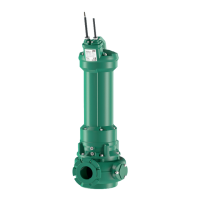en Installation and electrical connection
72 WILO SE 2019-10
6.5 Electrical connection
DANGER
Risk of death due to electrocution!
Improper conduct when carrying out electrical work can lead to death due to electric
shock! Electrical work must be carried out by a qualified electrician in accordance
with the locally applicable regulations.
DANGER
Risk of explosion due to incorrect connection!
• Always connect the pump to an electrical outlet outside the explosive area. If
the connection must be established within explosive atmospheres, the connec-
tion must be carried out in an Ex-rated housing (ignition protection class ac-
cording to DINEN60079‑0)! Non-compliance may lead to a risk of fatal injury
from explosion!
• Connect the equipotential bonding conductor to the earth terminal indicated.
The earth terminal is installed in the area near the connection cables. Use cable
cross-sections as per locally applicable regulations for the equipotential bond-
ing conductor.
• The connection must always be carried out by a qualified electrician.
• For the electrical connection, also note the additional information in the chapter
on potentially explosive areas found in the appendix of these installation and
operating instructions!
ƒ The mains connection must match the specifications on the rating plate.
ƒ Power supply on mains side for three-phase current motors with clockwise rotating
field.
ƒ Lay the connection cable in accordance with the locally applicable regulations and
connect it according to the wire assignment.
ƒ Connect the monitoring devices and check their function.
ƒ Earth the device properly in accordance with applicable local regulations.
6.5.1 Fuse on mains side
Circuit breaker
The size and switching characteristics of the circuit breakers must conform to the rated
current of the connected product. Observe local regulations.
Motor protection switch
Make provision for an on-site motor protection switch for devices without a plug! The
minimum requirement is a thermal relay/motor protection switch with temperature
compensation, differential triggering and anti-reactivation device in accordance with
the local regulations. In case of sensitive mains, make provision for the installation on-
site of other protective equipment (e.g. overvoltage, undervoltage or phase failure re-
lay, etc.).
Residual-current device (RCD)
Comply with the regulations of the local energy supply company! The use of a residual-
current device is recommended.
If persons come into contact with the device and conductive fluids, secure the connec-
tion with a residual-current device (RCD).
6.5.2 Maintenance tasks
Carry out the following maintenance tasks prior to installation:
ƒ Check the insulation resistance of the motor winding.
ƒ Test the resistance of the temperature sensor.
There are several reasons if the measured values differ from the specifications:
ƒ Humidity in the motor.
ƒ Humidity in the connection cable.
ƒ Monitoring device faulty.
Contact customer service in the event of a fault.

